Northern Thailand
Friday 5 November 1999 – Friday 19 November
1999
 It was raining when we landed in
Phuket and it was raining when we left three days later.
So much for a week in the sun, relaxing and recharging the batteries!
High season prices, but not a ray of sun to be seen.
We felt for the holidaymakers who had flown in from Europe for their
winter
It was raining when we landed in
Phuket and it was raining when we left three days later.
So much for a week in the sun, relaxing and recharging the batteries!
High season prices, but not a ray of sun to be seen.
We felt for the holidaymakers who had flown in from Europe for their
winter 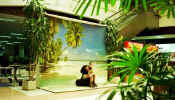 getaway only to find rain clouds and wind, but made the most of our time
sightseeing in the rain and touring round in a rented jeep.
Pippa had been to Phuket five or six years previously and found it
decidedly more built up and touristy; in fact, although Phuket has long been one
of Thailand’s wealthier areas, tourism is now its biggest source of
income. Everything had risen
dramatically in cost and we didn’t even feel inclined to check out the
reputedly world-class diving. Instead we
decided to spend the next couple of weeks exploring northern and central
Thailand.
getaway only to find rain clouds and wind, but made the most of our time
sightseeing in the rain and touring round in a rented jeep.
Pippa had been to Phuket five or six years previously and found it
decidedly more built up and touristy; in fact, although Phuket has long been one
of Thailand’s wealthier areas, tourism is now its biggest source of
income. Everything had risen
dramatically in cost and we didn’t even feel inclined to check out the
reputedly world-class diving. Instead we
decided to spend the next couple of weeks exploring northern and central
Thailand.
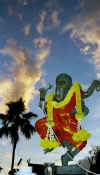
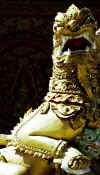 Our first stop was Chiang Mai,
the vibrant northern capital which boasts over 300 temples. Nowadays a modern, cosmopolitan city, it has managed to
retain much of its charm and traditional atmosphere.
Indeed, it has many of the cultural advantages of being in Bangkok, but fewer of the disadvantages such as traffic jams and pollution.
The old city is a neat square bounded by moats and partial walls.
Much of it is still in its original form, and
many of Chiang Mai’s important temples are within the moat, with others
to the north and west.
Our first stop was Chiang Mai,
the vibrant northern capital which boasts over 300 temples. Nowadays a modern, cosmopolitan city, it has managed to
retain much of its charm and traditional atmosphere.
Indeed, it has many of the cultural advantages of being in Bangkok, but fewer of the disadvantages such as traffic jams and pollution.
The old city is a neat square bounded by moats and partial walls.
Much of it is still in its original form, and
many of Chiang Mai’s important temples are within the moat, with others
to the north and west.
Temples, however, were not to be
our number one priority. One thing
we had gleaned from the Thailand guidebook was that Chiang Mai was the place to
take a Thai cookery course. Having both fallen for Thai cuisine at our very first meal in
Bangkok, we were full of 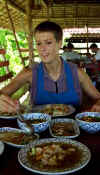 enthusiasm at learning how to prepare some of the
dishes we had come to most enjoy. And
so on our very first day in town, we signed up for the best course in town and
for the next two days, spent our time chopping chilies and slaving
enthusiasm at learning how to prepare some of the
dishes we had come to most enjoy. And
so on our very first day in town, we signed up for the best course in town and
for the next two days, spent our time chopping chilies and slaving 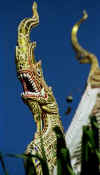 over a hot
wok. With remarkable results!
We have to admit that at the time of writing this episode up, we have yet
to try out our newly acquired skills here in the US, but as soon as we find
some willing guinea pigs, we will …
over a hot
wok. With remarkable results!
We have to admit that at the time of writing this episode up, we have yet
to try out our newly acquired skills here in the US, but as soon as we find
some willing guinea pigs, we will …
Once we’d covered the cuisine
angle, we started on the wat spotting … not an insignificant task.
Interspersed with souvenir shopping, we probably ended up accomplishing
more of the latter but nonetheless managed to consume a countless number of
rolls of film. Some of Chiang
Mai’s most famous temples have been places of pilgrimage for centuries and
have also become repositories of some of the county's finest examples of religious art.
We spent enjoyable days learning about the many different architectural styles, complex layouts
and images; suffice it to say many of these temples are breathtaking.
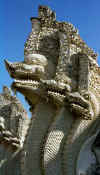
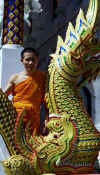
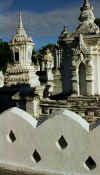
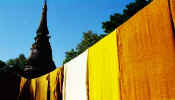
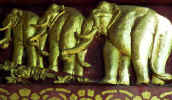
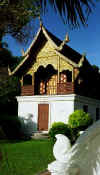
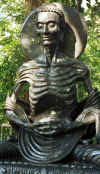

The following day, we hired a
car and driver and headed out to see some of the sights on the outskirts of
town. One place we were keen to
visit was the Tribal Museum, which houses a large collection of handicrafts,
costumes, household utensils, agricultural  tools and musical instruments, along
with various informative displays concerning the key cultural features and
backgrounds of each of the major hill-tribes in Thailand.
It was a fascinating learning experience and one that we would get a lot
out of before the end of our trip. Although
some of their culture is being eroded by modernization and foreign tourism, as
in Indonesia, many of these tribes still practice their ancient customs, wear
traditional dress and live in old-style villages, albeit that, for the
most part, they now have access to electricity and road networks.
tools and musical instruments, along
with various informative displays concerning the key cultural features and
backgrounds of each of the major hill-tribes in Thailand.
It was a fascinating learning experience and one that we would get a lot
out of before the end of our trip. Although
some of their culture is being eroded by modernization and foreign tourism, as
in Indonesia, many of these tribes still practice their ancient customs, wear
traditional dress and live in old-style villages, albeit that, for the
most part, they now have access to electricity and road networks.
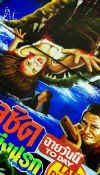 The landscape
surrounding Chiang Mai is a glorious mix of mountains, forests and waterfalls. Not
having been able to take advantage of a sunny interlude in Phuket, we decided to
stay on for a few extra days before heading further north to do some trekking
and enjoy the peace and serenity of this wonderful countryside. We might not have got further than the city limits, however, when Eric
decided to query a phone bill we were presented with on checking out of our
hotel. Confronted by an antagonistic manager who did not seem to
want to try resolving the issue, we paid what we believed we owed and left the
hotel, only to be arrested by the doorman and hear shouts of “call the
police”
The landscape
surrounding Chiang Mai is a glorious mix of mountains, forests and waterfalls. Not
having been able to take advantage of a sunny interlude in Phuket, we decided to
stay on for a few extra days before heading further north to do some trekking
and enjoy the peace and serenity of this wonderful countryside. We might not have got further than the city limits, however, when Eric
decided to query a phone bill we were presented with on checking out of our
hotel. Confronted by an antagonistic manager who did not seem to
want to try resolving the issue, we paid what we believed we owed and left the
hotel, only to be arrested by the doorman and hear shouts of “call the
police” 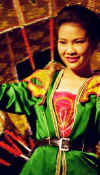 drifting after us. We
shall forever to indebted to a wonderful Thai lady and her American husband who
intervened on our behalf and helped resolve the issue and were grateful to have
avoided an incident similar to our arrest at the Chinese border five months
earlier.
drifting after us. We
shall forever to indebted to a wonderful Thai lady and her American husband who
intervened on our behalf and helped resolve the issue and were grateful to have
avoided an incident similar to our arrest at the Chinese border five months
earlier.
Before we left Chiang Mai,
however, we spent an evening at a Thai cultural show watching some traditional
Thai dancing. Dinner was served on
the ground on a pedestal tray made of bamboo strips and rattan woven together.
The first part of the evening comprised seven classical northern Thai
dances, including bizarre renditions of the 'Fingernail Dance' (usually
performed when greeting honorable guests or state officials), the 'Sword
Dance' (developed from an ancient martial art and described as having
ferocious beauty), and the 'Silk-Reeling Dance', among others.
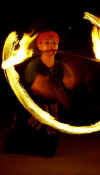 The second half of the evening comprised
a selection of hill-tribe dances performed by local hill-tribes from the
villages surrounding Chiang Mai. This
gave us a great opportunity to practice our hill-tribe identification skills
developed at the Tribal Museum.
The second half of the evening comprised
a selection of hill-tribe dances performed by local hill-tribes from the
villages surrounding Chiang Mai. This
gave us a great opportunity to practice our hill-tribe identification skills
developed at the Tribal Museum.
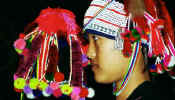 On the way back to the hotel, we
spent some time wandering through the night bazaar, a wonderful menagerie of
stalls selling everything from hill-tribe souvenirs to designer labels (both
fake and licensed) at very low prices. The
streets are taken over completely by these stalls and covered markets, closed by
day, become a hive of activity. Apparently, the night bazaar is the legacy of the original
Yunnanese (southern Chinese) trading caravans that stopped over here along the ancient trade route
between China and Burma … not that you’d know without the help of a
guidebook!
On the way back to the hotel, we
spent some time wandering through the night bazaar, a wonderful menagerie of
stalls selling everything from hill-tribe souvenirs to designer labels (both
fake and licensed) at very low prices. The
streets are taken over completely by these stalls and covered markets, closed by
day, become a hive of activity. Apparently, the night bazaar is the legacy of the original
Yunnanese (southern Chinese) trading caravans that stopped over here along the ancient trade route
between China and Burma … not that you’d know without the help of a
guidebook!